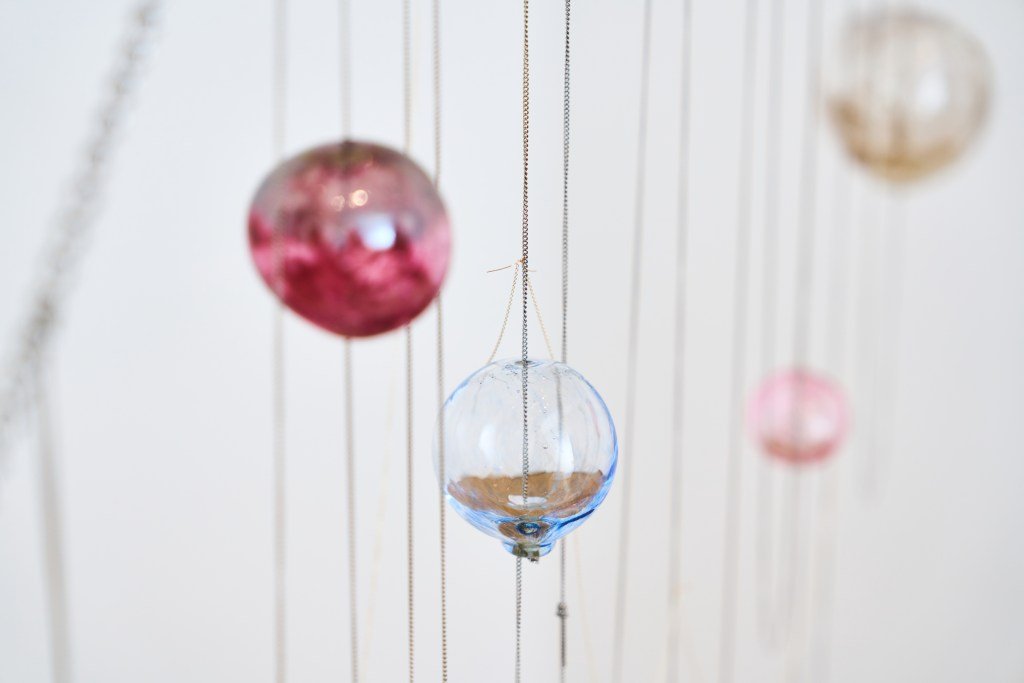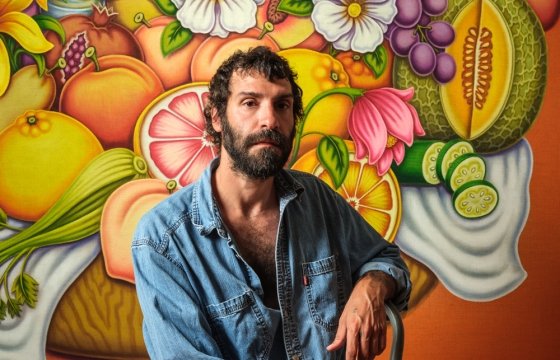

HOUSTON — To say that I’m drawn to Jillian Conrad’s art might sound like an all-too-easy pun in a review of a show that explores drawing, but the sentiment holds. Since the early aughts, I’ve been following the psychic line of her practice. Conrad’s work marks the distance between what we see and how we name it, drawing connections across time and space.
Conrad is known primarily for her sculptures, but her line of thought is inherently tied to drawing’s animating energy. For What drawing can be: four responses, she presents an installation of five new works that we would normally label as sculptures, alongside site-specific works by Teresita Fernández, Tony Lewis, and Constantin Luser.
“Cetus” (all works 2025) partially levitates in the gallery, its colored glass orbs strung along thin metal necklace chains, sections of which are tethered to a chunk of asphalt on the ground, while others reach, drape, and collapse in squiggles on the floor. The sculpture traces the celestial constellation of the same name, citing Greek mythology and early forms of drawing and mapping. Centered in the gallery, “Cetus” serves as an orientation device, offering navigational clues for and readings of Conrad’s other works. The chain, with its numerous thin yet sturdy interlocking loops, is mirrored and magnified in the relaxed grid of “Letter.” This piece is formed by a string net suspended from the ceiling and embedded with pieces of hand-formed, illegible pewter letters that spell “I would gladly spend the night writing to you” in English on one side and French on the other. The net, with its slouching, figurative form and airy nature, can be read as embodying the poetics of both language and space, and a collapsing of interior and exterior.

Many of Conrad’s works reference an event, a material life before and beyond the gallery. “Letter” is informed by an actual handwritten correspondence from a woman to her husband in 1758, one of 104 lost letters to sailors from the Seven Years’ War. The ink and folded paper of the original letters — at the time, precious and pricey — are, like drawing itself, thinking and feeling made visible, tangible. The sculpture accentuates the kind of contradictions and connections that Conrad finds irresistible, what she sees as a “reciprocity with the world” when parts become whole(s), or in this case, when something can be found precisely because it has been lost. Unbeknownst to her while creating the works, Cetus would’ve been visible in the night sky to the 18th-century sailors.
Such gaps between then and now, this and that, are also evident in “Fork,” composed of a rose branch and a small piece of brass. The piece is somewhat absurd, a little weird, even funny — elements that hint at Conrad’s surrealist tendencies. As viewers move through the gallery and their orientation to the sculpture changes, a spatial separation between the branch and the brass is revealed. Here, Conrad uses the psychic line as a conceptual threshold, inviting viewers to cross over into a world of imagination, moving beyond what we see. In her artist talk, she noted that this gap evokes, among other things, the section of a branch held in and hidden by a bird’s beak. Although not visible to us, we never question its existence. I see “Fork” as a framing device for Conrad’s entire installation: an elegant gesture that draws attention to the connection between looking, thinking, and making.



What drawing can be: four responses continues at the Menil Drawing Institute (1533 Sul Ross Street, Houston, Texas) through August 10. The exhibition was curated by Edouard Kopp and Kelly Montana.
Editor’s Note: Hyperallergic’s standard image policy is to run photographs taken by our reviewers to authentically represent their experience. An exception was made in this review due to the venue’s restrictions on photography.


